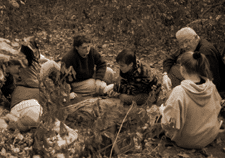We have many resources for students, researchers, and law enforcement agencies. These include skeletal collections, decomposition facilities, and more. To request permission for access to any of these facilities please contact Dawnie Steadman and complete the Research Request forms.
The Body Farm: The Anthropology Research Facility

Dr. Bass and students at the Facility
The Anthropology Research Facility, commonly known as The Body Farm, opened at its present location in 1980 by Dr. William M. Bass, provides an ideal setting to scientifically document postmortem change. This outdoor field laboratory enables the investigation of parameters which are crucial in time since death estimates. Donated remains make this research possible and simultaneously provide a modern osteological teaching collection. These individuals are essential for providing education and training in forensic anthropology and skeletal biology for students and law enforcement agencies. They are also invaluable for updating demographic and biological standards. Please contact Dawnie Steadman regarding use of this facility.
UTK Donated Skeletal Collection
This skeletal collection was started in 1981 under the direction of Dr. Bass. The collection currently contains nearly 1700 individuals and growing. The collection also contains over 50 cremated individuals. The goal of the body donation program is to build this collection of known individuals for research purposes. Potential research using this collection ranges from skeletal biology and forensic to dental, biomedical and genetics as well as other fields. There are also blood, hair, and fingernail samples from the donors available for research. The demographic profile includes predominantly Americans of European and African ancestry, and a smaller portion of Hispanic ancestry. The age range of the individuals is from fetal up to 101 years. Please contact Dawnie Steadman regarding use of this facility.
Forensic Anthropology Data Bank
The Forensic Anthropology Data Bank (FDB) was started in 1986 with a grant from the National Institute of Justice. The FDB contains extensive demographic information for many cases, including place of birth, medical history, occupation, stature, and weight. The skeletal information for cases includes cranial and postcranial metrics, suture closure information, various aging criteria scores, non-metric cranial information, perimortem trauma, congenital traits, and dental observations. In addition, we are currently collecting 3D coordinate data for cases that come throughout the University of Tennessee and other contributing organizations and institutions.
Oak Ridge National Laboratory
The Forensic Anthropology Center has enjoyed a constructive research relationship with the Oak Ridge National Laboratory. Some of our recent research initiatives include decomposition, biometrics and remote sensing studies.
Recent Research
Our faculty and students are involved in a wide range of research involving our collections as well as our facilities. Because of the wealth of resources here, many of the graduate student research projects utilize the ARF or collections housed at the FAC. We also host many visiting scholars that utilize either the ARF or one or more of our skeletal collections. International scholars have visited us from Europe, Australia, Japan and Korea.